In November the European Parliament’s cult
问题:
In November the European Parliament’s culture and education committee is due to move forward on its proposed "audiovisual media services" directive, before sending it to the full parliament in December. The new rules update and relax the "Television Without Frontiers" directive of 1989, which opened Europe’s national markets. But critics complain that they also seek to extend fusty regulations from the era of broadcast television to today’s very different technologies. Rules on advertising, the protection of children and so on could potentially also apply to all kinds of video streams, including video blogs, online games and mobile-video services.
This could have a chilling effect on innovation and risks stifling emerging technologies with rules designed for another age, says Chris Marsden of RAND Europe, a think-tank that has analysed the potential impact of the proposed rules for Ofcom, Britain’s media and telecoms regulator. "Regulators have to be thoughtful. They cannot predict the future of television "or the internet—no one can," says Niklas Zennstr. m, a co-founder of Skype, who is now setting up an internet television firm.
The proposed rules may be unrealistic as well as onerous. The idea that websites can be regulated like broadcasters, which are required to keep strict records of what they show in order to help watchdogs investigate complaints, is untenable. Firms could simply relocate outside the European Union to escape the new rules. Last week Ruth Hieronymi, a member of parliament, said she would introduce wording that might help to overcome some of the objections.
Behind the debate is the question of how best to balance competition and protection. Traditional broadcasters worry that they will be shackled by regulations while brisk start-ups can do as they please—so they like the idea of extending regulation to their new rivals. But even if the rules are approved as they stand, they will not come into force until 2010. Such a long, slow process seems incongruous given the pace of technological change.
The word "onerous" (Line 1, Paragraph 4) most probably means ().
A.deceptive
B.burdensome
C.stringent
D.outrageous

